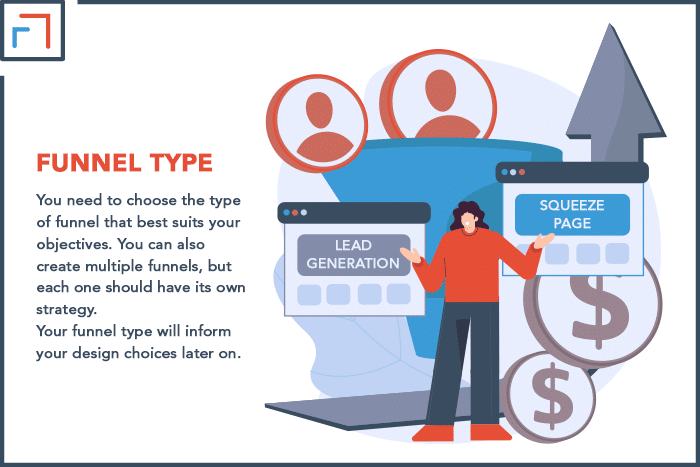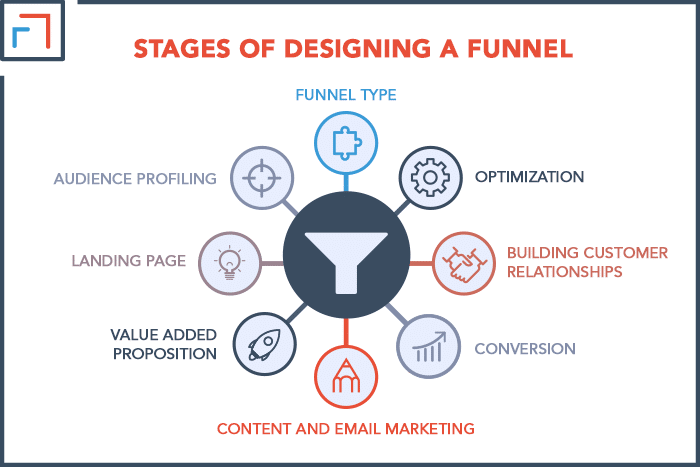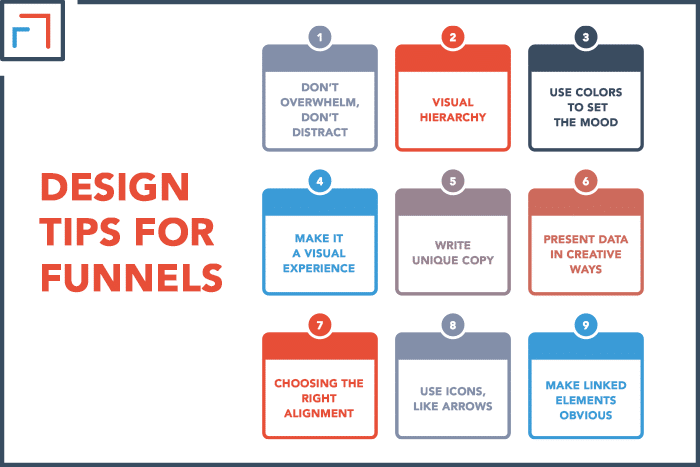Designing an effective funnel requires time and deliberation. Are you communicating with the right people? Does your design reflect your message? These questions and many more can be addressed with proper funnel design.
To design a funnel, you need to define your target consumer base and the type of funnel you will use to reach your goals. With this information, you design landing pages that focus on aesthetics, branding, and potential impact. Your unique selling point should also be clear in the funnel design.
Designing a funnel isn’t a complicated process, but there are different ways to make your design more appealing and powerful. Below we’ll talk about proper funnel structure and good design tactics.
Stages Of Designing A Funnel
1. Funnel Type
Before you start designing your funnel, you need to choose the type of funnel that best suits your objectives.
You can also create multiple funnels, but each one should have its own strategy.
You could choose a Lead Generation funnel if you are a B2B company and want to identify your target audience before converting them.
Similarly, you might want to build a Squeeze Page funnel that focuses on getting audience contact details. Your funnel type will inform your design choices later on.

2. Audience Profiling
Once you have decided on the type of funnel to use, research the audience you want to attract with your funnel.
Use your research to create an audience persona. This will help you to design relevant and effective stages for your funnel.
3. Landing Page
Your landing page elements, copy, and visuals must be designed according to your funnel goals.
If you have a sales funnel, center your landing pages around new products, limited offers, and promotions.
A landing page is a palace where you can capture your audience’s attention.
A targeted landing page should have a clear and direct call to action.
Don’t forget to mention your company’s unique selling point so that your customers know what they will receive when purchasing.
4. Value Added Proposition
Since we mentioned the unique selling point, it’s important to discuss how to write your value proposition.
If you promise a service or product to your customer, you must ensure that it is relevant to their needs.
Understand what you bring to the table and connect it to your target audience’s problem.
Try to identify the type of value you provide, i.e., technical, business, or personal.
You can then phrase your value proposition accordingly. This will help you gain access to your customers via emails or newsletters.
5. Content and Email Marketing
This is a strategic step where you can develop your audience’s interest and maintain their engagement with the brand.
In addition, email updates and newsletters can inform customers about relevant products and upcoming offers.
Similarly, you can direct them to blogs and articles which would generate traffic for your company’s website.
Additional content can also increase your visitors’ level of interest.
6. Conversion
Your funnel should have a safe and encrypted payment platform.
An e-commerce store or a clear landing page with product/service lists and prices is necessary for a smooth shopping experience for the customer.
To encourage conversion, you can include upsells, downsells, or cross-sells during this stage of the funnel.
Targeted and appealing product combos can give your customers the final push to make a purchase.
7. Building Customer Relationships
Your company’s growth depends largely on your existing customers. Therefore, you sometimes need to prioritize them more than new customers.
Help them feel valued by offering premium customer service through prompt responses and follow-ups after purchase(s).
Personalized reminder emails can also be sent periodically. This would foster a deeper and more direct relationship with customers.
Moreover, rewarding your customers through loyalty programs or exclusive offers will make them feel special and cherished.
8. Optimization
You can achieve significant growth by reassessing and analyzing your funnel strategies and fixing the flaws.
Focus on addressing these issues and optimizing your funnel. You can use A/B testing for this stage to test different iterations of your copy.

Design Tips For Funnels
1. Don’t Overwhelm, Don’t Distract
Make sure that you don’t bombard the viewers with too much text. It’s also possible to overdo it with the visual elements like videos, images, and gifs.
Every element should have a purpose and work together to achieve the funnel objective. Design harmony encourages retention and is easy on the eyes.
2. Visual Hierarchy
Use headings and subheadings to direct the attention of your viewers to your most important points.
For example, you may want to use bold colors or large fonts for limited offers or a call to action.
Be strategic about the enlarged text since this will be the first thing the audience will notice. Therefore, arrange your text sizes according to their importance.
3. Use Colors To Set The Mood
The colors you use while designing your funnel will influence your audience’s emotions before they read the copy or notice the other visual elements.
This gives you the opportunity to make them feel a certain way before they find out about your product or service.
In many ways, your color palette will create your first impression. Use a color palette that is consistent with your brand, and don’t overwhelm visitors with too many colors.
4. Make It A Visual Experience
Effective funnel designs will grab and hold your attention. This is why you should use strong and targeted images/videos.
Not only do visual aids leave a more long-lasting impression, but they also provide an engaging brand experience.
5. Write Unique Copy
You need to convince your consumers to take a leap of faith and choose your service.
You can’t do that if your copy says the same thing that they have read or heard multiple times before.
Just telling them that your product is good for them isn’t enough.
Use metaphors and imagery to create emotional connections between your brand and a positive real-life experience.
6. Present Data in Creative Ways
Statistics can be a convincing strategy to win over customers, so make sure you’re not missing out because of poor presentation.
Make your data interesting by using illustrative infographics. This will keep your audience interested while also making it easy for them to understand the information.
7. Choosing The Right Alignment
Alignment helps direct the focus of the viewer.
Whether you use centered, left, or right alignment for your design elements, you need to make sure it is consistent throughout your funnel landing page.
8. Use Icons Like Arrows
While designing your funnel, you need to consider how easy it is to navigate for your customers.
Icons are a quick way to point out where a specific tool or setting is placed or how to get there.
These icons should be easy to see and interpret. You’d be missing the point if your customer spends a lot of time trying to understand what the icon represents.
9. Make Linked Elements Obvious
Links are important for generating and directing traffic. But make sure not to link irrelevant elements because this will cause clutter and confusion.
Moreover, you have to make your linked elements apparent by playing with the typography, font color, or rectangles behind the linked elements (like buttons).

Key Takeaways
Before designing your funnels, research your audience and write down your target goals.
Also, remember to mention the value you provide to customers by using associative language.
You can deliver a visual experience to your customers throughout your funnel by using copy, images, links, and icons.
Lastly, it is important to provide a smooth customer experience through professional support and by continually improving your funnel design.
